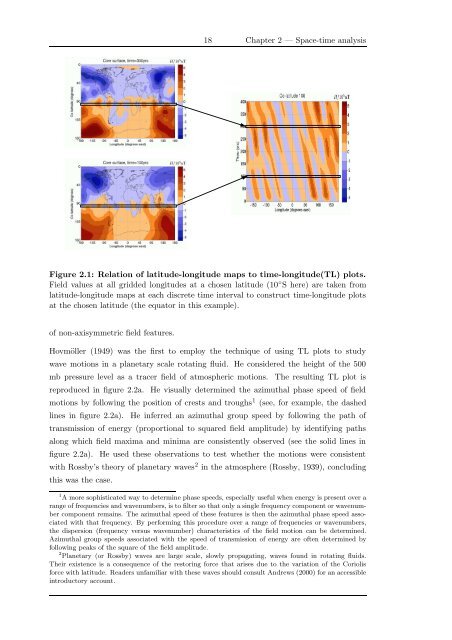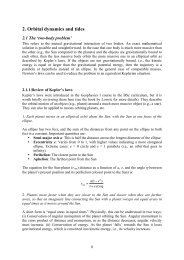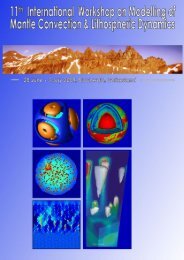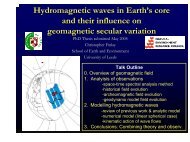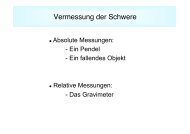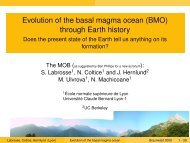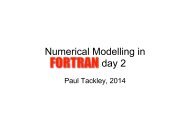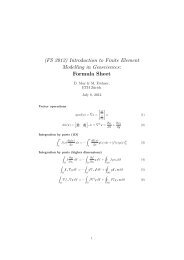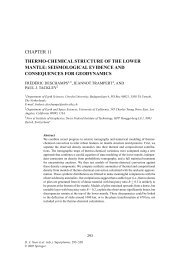Hydromagnetic waves in Earth's core and their influence on ...
Hydromagnetic waves in Earth's core and their influence on ...
Hydromagnetic waves in Earth's core and their influence on ...
You also want an ePaper? Increase the reach of your titles
YUMPU automatically turns print PDFs into web optimized ePapers that Google loves.
18 Chapter 2 — Space-time analysisFigure 2.1: Relati<strong>on</strong> of latitude-l<strong>on</strong>gitude maps to time-l<strong>on</strong>gitude(TL) plots.Field values at all gridded l<strong>on</strong>gitudes at a chosen latitude (10 ◦ S here) are taken fromlatitude-l<strong>on</strong>gitude maps at each discrete time <str<strong>on</strong>g>in</str<strong>on</strong>g>terval to c<strong>on</strong>struct time-l<strong>on</strong>gitude plotsat the chosen latitude (the equator <str<strong>on</strong>g>in</str<strong>on</strong>g> this example).of n<strong>on</strong>-axisymmetric field features.Hovmöller (1949) was the first to employ the technique of us<str<strong>on</strong>g>in</str<strong>on</strong>g>g TL plots to studywave moti<strong>on</strong>s <str<strong>on</strong>g>in</str<strong>on</strong>g> a planetary scale rotat<str<strong>on</strong>g>in</str<strong>on</strong>g>g fluid. He c<strong>on</strong>sidered the height of the 500mb pressure level as a tracer field of atmospheric moti<strong>on</strong>s.The result<str<strong>on</strong>g>in</str<strong>on</strong>g>g TL plot isreproduced <str<strong>on</strong>g>in</str<strong>on</strong>g> figure 2.2a. He visually determ<str<strong>on</strong>g>in</str<strong>on</strong>g>ed the azimuthal phase speed of fieldmoti<strong>on</strong>s by follow<str<strong>on</strong>g>in</str<strong>on</strong>g>g the positi<strong>on</strong> of crests <str<strong>on</strong>g>and</str<strong>on</strong>g> troughs 1 (see, for example, the dashedl<str<strong>on</strong>g>in</str<strong>on</strong>g>es <str<strong>on</strong>g>in</str<strong>on</strong>g> figure 2.2a).He <str<strong>on</strong>g>in</str<strong>on</strong>g>ferred an azimuthal group speed by follow<str<strong>on</strong>g>in</str<strong>on</strong>g>g the path oftransmissi<strong>on</strong> of energy (proporti<strong>on</strong>al to squared field amplitude) by identify<str<strong>on</strong>g>in</str<strong>on</strong>g>g pathsal<strong>on</strong>g which field maxima <str<strong>on</strong>g>and</str<strong>on</strong>g> m<str<strong>on</strong>g>in</str<strong>on</strong>g>ima are c<strong>on</strong>sistently observed (see the solid l<str<strong>on</strong>g>in</str<strong>on</strong>g>es <str<strong>on</strong>g>in</str<strong>on</strong>g>figure 2.2a).He used these observati<strong>on</strong>s to test whether the moti<strong>on</strong>s were c<strong>on</strong>sistentwith Rossby’s theory of planetary <str<strong>on</strong>g>waves</str<strong>on</strong>g> 2 <str<strong>on</strong>g>in</str<strong>on</strong>g> the atmosphere (Rossby, 1939), c<strong>on</strong>clud<str<strong>on</strong>g>in</str<strong>on</strong>g>gthis was the case.1 A more sophisticated way to determ<str<strong>on</strong>g>in</str<strong>on</strong>g>e phase speeds, especially useful when energy is present over arange of frequencies <str<strong>on</strong>g>and</str<strong>on</strong>g> wavenumbers, is to filter so that <strong>on</strong>ly a s<str<strong>on</strong>g>in</str<strong>on</strong>g>gle frequency comp<strong>on</strong>ent or wavenumbercomp<strong>on</strong>ent rema<str<strong>on</strong>g>in</str<strong>on</strong>g>s. The azimuthal speed of these features is then the azimuthal phase speed associatedwith that frequency. By perform<str<strong>on</strong>g>in</str<strong>on</strong>g>g this procedure over a range of frequencies or wavenumbers,the dispersi<strong>on</strong> (frequency versus wavenumber) characteristics of the field moti<strong>on</strong> can be determ<str<strong>on</strong>g>in</str<strong>on</strong>g>ed.Azimuthal group speeds associated with the speed of transmissi<strong>on</strong> of energy are often determ<str<strong>on</strong>g>in</str<strong>on</strong>g>ed byfollow<str<strong>on</strong>g>in</str<strong>on</strong>g>g peaks of the square of the field amplitude.2 Planetary (or Rossby) <str<strong>on</strong>g>waves</str<strong>on</strong>g> are large scale, slowly propagat<str<strong>on</strong>g>in</str<strong>on</strong>g>g, <str<strong>on</strong>g>waves</str<strong>on</strong>g> found <str<strong>on</strong>g>in</str<strong>on</strong>g> rotat<str<strong>on</strong>g>in</str<strong>on</strong>g>g fluids.Their existence is a c<strong>on</strong>sequence of the restor<str<strong>on</strong>g>in</str<strong>on</strong>g>g force that arises due to the variati<strong>on</strong> of the Coriolisforce with latitude. Readers unfamiliar with these <str<strong>on</strong>g>waves</str<strong>on</strong>g> should c<strong>on</strong>sult Andrews (2000) for an accessible<str<strong>on</strong>g>in</str<strong>on</strong>g>troductory account.


